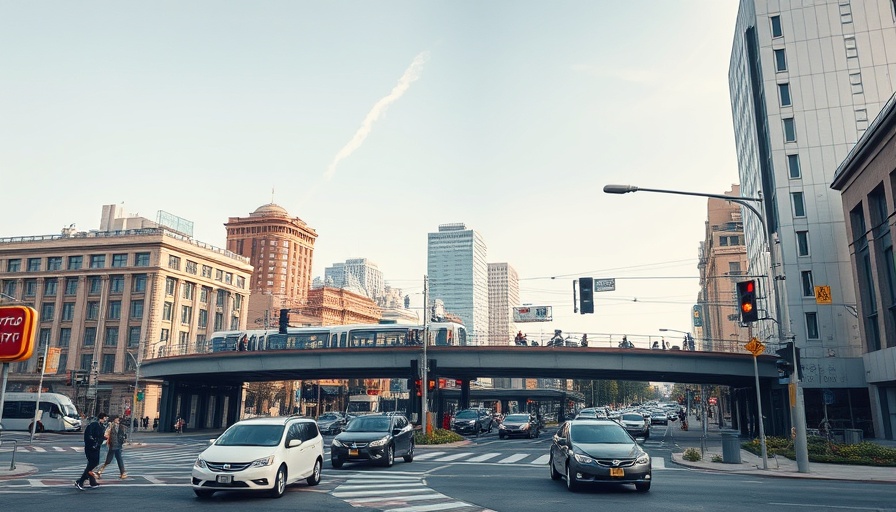
Pacific Avenue's Overhaul: A Much-Needed Transformation
Residents of Long Beach are on the cusp of witnessing a significant transformation along Pacific Avenue, a road long plagued by dangerous speeding and alarming rates of vehicular collisions. This redesign, aimed at enhancing safety and accessibility, aims to create a more pedestrian-friendly environment that encourages walking and biking.
Understanding the Redesign
The city’s $34 million project includes the introduction of protected bike lanes, widened sidewalks, and additional pedestrian crossings. These changes are directed by statistics that highlight a troubling trend: a recent study indicated only 14% of drivers adhere to the 25 mph speed limit on Pacific Avenue. Since 2020, nine fatalities have occurred along this stretch, most involving pedestrians, emphasizing the urgent need for reform.
As Paul Van Dyk, a traffic engineer with the city, explains, minimizing available lanes through a “road diet” is a method that effectively forces vehicles to slow down. With reduced speed comes increased safety for everyone using the roadway—from cyclists to pedestrians. A shift in design not only protects non-drivers but also lessens the severity of accidents. Simply put, if drivers cannot zip in and out of traffic, their speeds are inherently curtailed.
Community Concerns: An Open Conversation
The redesign is not without its pros and cons, and community feedback plays a central role in shaping the outcome. Alejandra Gutiérrez, a board member of the Wrigley Association, expressed that Pacific Avenue feels “pretty blighted” and emphasizes the necessity of improvements across the board. Residents frequently voice their concerns regarding poor lighting, insufficient protected lanes, and unsafe crosswalks—particularly at night. Moreover, as Gutiérrez notes, the addition of bike lanes could further impact parking availability in an already densely populated area.
Addressing these concerns, city planners must strike a balance between enhancing safety and ensuring the community’s needs for parking and accessibility are met. The project's evolution will depend on sustained community engagement and the feedback incorporated into the design.
Standard of Safety: Learning from Others
Long Beach is not alone in navigating roadway redesigns aimed at safety improvements. Cities across the United States have seen significant success with similar initiatives. For example, San Francisco's efforts to implement “slow streets” have effectively reduced injury rates among pedestrians and cyclists. By reimagining urban spaces and prioritizing alternative modes of transportation, these cities push forward towards becoming more sustainable and livable.
Such case studies provide invaluable insights for Long Beach, showcasing strategies that may further refine their redesign efforts. As Pacific Avenue undergoes its transformation, the city has a unique opportunity to implement proven best practices that prioritize safety.
Beyond the Avenues: Wider Implications
This project extends beyond the physical roadways; it encapsulates a more substantial movement toward sustainable urban living. Investing in bike lanes and enhanced pedestrian access may inspire residents to choose less harmful modes of transportation, such as cycling or walking, reinforcing a culture of health and environmental awareness.
The redesign also seeks to improve accessibility to local institutions. Key destinations—such as the Long Beach Convention Center and Long Beach City College—will be more easily reached without a vehicle, fostering a more interconnected community.
Looking Ahead: A Vision for Pacific Avenue
The projected timeline for completion still remains flexible, as the redesign waits for further refinements based on community feedback. The two-phase rollout will start east from Ocean Boulevard to Pacific Coast Highway, then proceed north to the Wardlow rail station near the 405 Freeway.
As residents await the changes to take place, optimism peaks for the potential revitalization of Pacific Avenue. Instituting a safer street design could not only mitigate dangerous driving but also invigorate the neighborhood, inviting increased foot traffic and encouraging businesses to flourish.
Conclusion: The Importance of Community Input
The Pacific Avenue redesign stands as a clear reflection of a community-driven initiative that pushes for a safer, more inclusive urban environment. Acknowledging the voices and concerns of residents throughout the planning process is crucial to achieving successful outcomes. Long Beach’s path forward is hopeful, but it requires an ongoing commitment from both civic leaders and community members to ensure that Pacific Avenue becomes a model of safety and accessibility for all.
 Add Row
Add Row  Add
Add 




Write A Comment